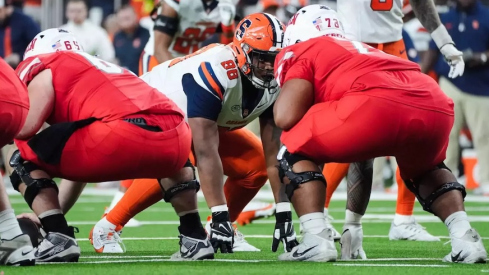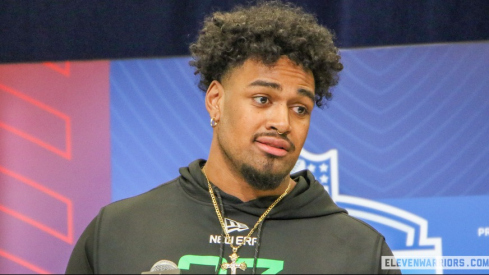
I wanted to take a momentary break from my breakdown of Ohio State's 2012 season to focus upon a pertinent topic relevant to the 'spread to run' offense.
After fits and starts, 2012 is undoubtedly the year that spread read principles took over the NFL. Without sufficient fanfare, three of the four top rushing offenses in the NFL are all driven by the use of shotgun read plays.
Indeed, Urban Meyer announced on The Dan Patrick Show this morning that he and his offensive staff spent the last month breaking down the NFL's new spread to run offenses.
Chris Brown has provided an invaluable analysis of the form that these principles are infiltrating the NFL, but I want to build on that and dig down even further to illustrate what is quickly becoming many NFL teams' favorite run play—inside zone read from the diamond formation.
San Francisco has spearheaded this play and, as Meyer discussed, they have even added a wrinkle that Meyer had not seen and wants to implement with Ohio State. This analysis is thus not only pertinent to the evolution of spread to run football, but could be of particular interest to Ohio State fans going forward.
The Rules are the Rules and Arithmetic is Still Arithmetic
The reason that read plays are succeeding in the NFL is the same reason that such plays have become so ubiquitous in college football—arithmetic. As Greg Schiano stated last year:
As I’ve tried to explain to people, whenever the guy who takes the snap is a threat to run, it changes all the math of defenses. That’s really what defense is, it’s getting your troops to where the ball is going to be. And when that guy holding it is a threat to run, it changes the numbers – minus-one.
NFL teams are thus discovering what Meyer found a decade ago—that the QB run threat constrains a defense from your base downhill run plays. In the NFL, just as in college football, the defense is always going to have two unblocked defenders—the counterparts to the ball carrier and the quarterback.
If the quarterback turns and hands off the football those two defenders will remain unblocked. But, if an offense uses its quarterback to essentially 'block' one unblocked defender by reading him, the offense has taken strides to even out that equation. The real advantage of read plays, then, is not simply to run your quarterback, but to make it easier to run the base zone plays that every NFL offense runs. This is why you see those teams leading the NFL in rushing yards.
The Diamond, the Pistol, and the Zone Read
Yet the embrace of read principles by NFL offenses has taken a particular form—inside zone read from the pistol diamond formation.

In this formation, the offense runs inside zone read with the quarterback and tailback turning away from the play-side, just as Chris Ault has done for years from the pistol. In this way, the play shares many characteristics with Meyer's base inside zone read play. Both are looking to overcome the lateral aspect of having a halfback next to a shotgun quarterback by instead getting the tailback quickly going north and south. With Meyer's inside zone, the running back's aiming point is the backside 'a' gap bubble where cutback lanes naturally develop with inside zone.

From the pistol, the tailback has the same aiming point, attacking the backside A gap and then 'bending' back to the frontside zone blocking.
As evident, the diamond formation has two H-backs or fullbacks. With the inside zone read from this look, both fullbacks are going to 'arc' block away from the play. The first fullback will take the first alley defender that shows. This allows for the offense to deal with a 'scrape exchange,' a common technique versus the zone read. With a scrape exchange, the backside linebacker and defensive end exchange responsibilities. The defensive end will crash while the linebacker will scrape around to play contain, in an attempt to confuse the QB's reads. But the h-back's arc block can account for this scraping linebacker in the alley.
The second fullback's arc block is more interesting. Just like the quarterback, he too will read the backside defensive end. If the end sits he will assume the quarterback will give to the tailback. He will thus block the defensive end just as he would on a traditional inside zone arc block, creating that backside A gap cutback.
On the other hand, if the backside end crashes the second fullback will 'log' block him (seal him inside) to ensure that he is no longer a threat to the expected quarterback keep. Once this is accomplished he too will release to the alley for the first opposing jersey he sees. As such, though the defensive end is being read, offenses are able to use the diamond formation to assign a blocker to him. Though Meyer did not specify, this 'read block' is likely the wrinkle he was referring to, and one that OSU may implement next fall.
Note that such a block is not limited to the diamond formation, but could be executed by any backside H-back.

Those Good Ol' One-on-One Matchups
But this particular look has quickly become popular because NFL teams can employ the zone read from the diamond formation as much to set up play-action passing as to run the football. NFL offenses are using the diamond formation for the same reasons Air raid teams do—force a defense to declare its safety box support and allow an offense to easily count numbers.
If a defense brings safeties to match the offense's arithmetic, suddenly the middle of the field is opened for play-action post-dig routes against corners maintaining outside leverage. This is aided by the play-action fake, which is particularly effective since the mesh point on run plays is a read. As such, this look picks up on two insights by Homer Smith: one, that spreading the field is not always a panacea; and two, that the most effective thing an offense can do is faking, and there is no better faking than option because to give or keep is not pre-determined.
The result is that these plays are giving young quarterbacks like Robert Griffin III and Colin Kaepernick relatively simple middle of the field 2 on 1 reads behind vacating linebackers (:48 second mark).
The upshot is that NFL offenses embracing this spread read play are able to take advantage of long-proven offensive principles that apply at any level of football—constraint, faking, and arithmetic. It will be interesting to see how NFL teams using read plays adapt once defenses begin using basic responses to the zone read and whether the NFL will expand their read concepts to embrace plays such as inverted veer, aka jet read or power read (early evidence suggests it is likely).
But given the adaptive staying power of these spread principles in college football against defenses focused upon stopping it, it is likely that read plays will continue to alter NFL offenses going forward. And, as evident by Meyer's comments, the symbiotic relationship between NFL and college teams running these same concepts will likely only further the development of the spread to run.

